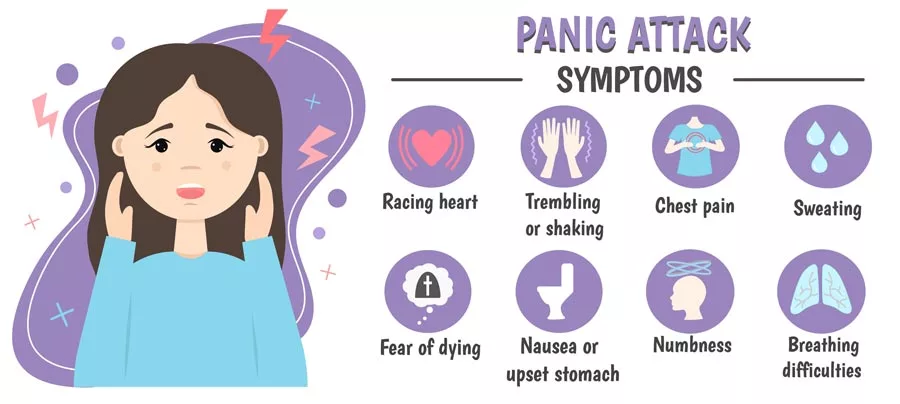Get Effective Treatment for Anxiety Disorders at Catalina
You have undoubtedly heard the term “anxiety” before, most likely used in correlation with a situation of increased stress. There’s a high probability you’ve probably used the time before to describe a particular mood or situation that caused heightened panic levels. Effective anxiety disorder treatment can help overcome this sense of distress and provide tools that help it from taking over your life.
Most people throw the term anxiety around many times without any regard for what individuals go through who suffer from anxiety or panic disorder. For these people, it’s not a term to be thrown around loosely or taken lightly.
The reality is that anxiety disorder is much more than a bill that is due you have to pay at the last minute. It goes far beyond the fender bender you just got into and the person you rear-ended.
Licensed Mental Health Treatment
For those who genuinely suffer from an anxiety disorder, it often does not even take a trigger to bring on a behavioral episode that feels like the weight of the world is crushing them. In the worst cases, an anxiety disorder can be so severe that those suffering from it are too frightened to leave their homes.
Many people assume that having anxiety means having anxiety – however, there are multiple forms of anxiety disorder, each with unique characteristics and symptoms.
Keep reading to find out more about the different anxiety disorders and how are they classified, along with forms of effective treatment like those offered at Catalina Behavioral Health.
What Are Anxiety Disorders?
Tension in the muscles and avoidant conduct are the most common physical manifestations of anxiety: the anticipation of a future problem.
Fear is an emotional response to an immediate threat and is more connected with a fight-or-flight reaction, which means either staying to fight or fleeing to escape harm. Fear can be caused by either an external or internal threat.
People suffering from anxiety disorders may try to avoid circumstances that bring on or exacerbate their symptoms. Performance at work, school, and personal relationships can all be negatively impacted. In most cases, the following fears or anxieties must be present for a person to be diagnosed with an anxiety disorder:
- The anxieties or fears must be well beyond the scope of the situation at hand or out of character for the individual’s age
- The anxiety must drastically affect the individual’s quality of life or ability to function normally.
The continuous and excessive worry that characterizes generalized anxiety disorder might make it challenging to go about one’s regular life. This persistent concern and tension may be accompanied by bodily symptoms, such as restlessness, a feeling of being on edge or easily fatigued, difficulty concentrating, muscle strain, or difficulty sleeping.
Most of the time, the worries are about mundane things like work responsibilities, the family’s health, or even very insignificant things like chores, car repairs, or appointments.
Panic Disorder

The occurrence of panic attacks, which are characterized by extreme feelings of both physical and mental anguish, is the primary sign that someone has panic disorder. During an episode, a combination of several of these symptoms will manifest themselves:
- Feeling detached or disassociated from the present
- Frequent hot or cold flashes
- Symptoms such as a racing heart, palpitations, or hammering in the chest
- Sweating
- Indicated by trembling or shaking from anxiety.
- A sensation of being suffocated or shortness of breath may be present.
- Having feelings of vertigo, lightheadedness, or fainting
- Sensations of numbness or tingling
- Nausea and pain in the abdomen region
Due to the severity of the symptoms, many people with panic attacks are under the false impression that they suffer from a life-threatening illness such as a heart attack or another similar condition. It’s not uncommon for them to take a trip to the emergency department.
Attacks of panic might be anticipated, such as a reaction to something the sufferer is afraid of, or they can come about suddenly and seemingly for no reason. The start of the panic disorder typically occurs between the ages of 20 and 24. Sometimes other mental disorders are present beneath the surface, and panic attacks are just a byproduct.
This happens most frequently in the case of PTSD. Individuals with untreated PTSD commonly suffer from anxiety and panic attacks because of their flashbacks of past trauma.
Phobias
A specific phobia is an extreme and unwarranted fear of a particular circumstance, item, or activity that, in most cases, does not provide an actual risk to one’s health. Patients know their anxiety is out of proportion but cannot conquer it. Because these concerns cause so much anguish, some people may go to any extent necessary to protect themselves from the things they are afraid of. There is the fear of public speaking, the fear of flying, and the fear of spiders as examples.
Agoraphobia
Agoraphobia is the fear of being in settings from which one may find it difficult or embarrassing to flee or from which one may find it challenging to obtain assistance if one experiences panic symptoms. Working or holding down a regular job is all but impossible. Generally, the following situations must be present to receive this diagnosis:
- Fear of waiting in line or being among a large number of people
- Fear of eating in a restaurant or shopping in a store
- Fear of being by one’s self outside the house
- Fear of being in open areas
- Fear of taking a taxi, bus, or plane
The person will either avoid the circumstance at all costs, insist on being accompanied at all times, or put up with great worry or anxiety. If not addressed, agoraphobia can progress to the point that the sufferer is unable to leave the safety of their home. A person can only be diagnosed with agoraphobia if the fear is severe enough to cause significant distress or if it severely disrupts the individual’s ability to engage in routine day-to-day activities.
Social Anxiety

A person who suffers from social anxiety disorder has a significant fear of being humiliated, ashamed, rejected, or looked down on in social encounters. This fear causes the person to experience significant anxiety and discomfort.
People suffering from this condition will either try to avoid the circumstance or face it with great dread. The overwhelming fear of speaking in public, making new acquaintances, or eating or drinking in public are all examples that frequently accompany social anxiety. The worry or anxiety lasts for at least six months to a year, making it challenging to operate generally in daily life.
Separation Anxiety
A person who suffers from separation anxiety disorder has an abnormally high level of fear or anxiety when faced with the prospect of being separated from the people to whom they are attached. The emotion goes beyond ordinary for the person’s age; it lasts for an extended period (at least four weeks in youngsters and six months in adults), making it difficult for the individual to operate normally.
Individuals with this disorder may refuse to do anything without the one they’re attached to. Usually, the signs of separation anxiety develop early in childhood but continue to progress into adulthood.
With such a detailed list of anxiety disorders, it’s often difficult to pinpoint where the challenges stem.
Licensed Addiction Treatment
What Are the Causes of Anxiety Disorders?
The primary cause of any anxiety disorder is stress. While this may seem like a simple answer, the issue is far more complex.
Citing stress may seem like a blanket term that is easy to digest but locating the root cause of the disorder is much more complicated. A buildup of pressure triggers any anxiety disorder.
This can be a buildup over a long period, over one or more events. It can be a generally stressful lifestyle capped off by a significant event that acted as a breaking point.
Things like stress at work, over money, a stressful marriage, losing a loved one, or other similar events, especially when experienced over a long period, will lead to anxiety disorder. Again, a person can maintain a semi-normal life and deal with some of these elements until one final crushing, stressful event finally sends everything crashing down.
When this happens, it is not uncommon for individuals to experience what’s known as stress-induced psychosis. It can be terrifying if you’re unfamiliar with this condition.
Before the situation becomes this severe, it’s possible to diagnose an individual and avoid the worst possible situation. Diagnosing isn’t as complicated as you think and generally requires a short assessment.
How Are Anxiety Disorders Diagnosed?

When a client goes in with symptoms of an anxiety disorder, the diagnosis is usually established by conducting an assessment. Generally, this consists of a series of questions the physician relies on the client to answer honestly and descriptively.
They usually will ask about the symptoms the client has been experiencing. The client will be required to go into detail regarding the symptoms, including how long they’ve been going on and how often they manifest.
The doctor will also ask how long the episodes last and how severe they become. Usually, the anxiety episodes and panic attacks must have been present for at least six consecutive months to receive a diagnosis of an anxiety disorder.
In addition, these attacks must affect the client’s life in a way that prohibits them from living a normal life. This can include not being able to go anywhere in public, not being able to hold down a job, or not being able to have a typical dynamic with friends and family members.
Treating anxiety disorders is another matter that requires careful planning and a delicate approach. Finding the most effective therapy methods may be a trial-and-error process.
This may or may not include a medication regimen and typically always includes some form of therapy such as CBT.
Medication Management for Mental Health
Medication management for mental health is often a large part of treatment. However, when possible, the ultimate goal is to eliminate the medication from the regimen eventually.
This is a fundamental goal because of the power of the medications clients usually receive. Most of the prescription drug options prescribed to clients range anywhere from anti-depressants to benzodiazepines and mood stabilizers.
Some of the most common prescription drugs given the patients for anxiety disorders include:
- Xanax for acute anxiety disorder issues
- Clonazepam for extended release
- Valium
- Various antidepressants
- Mood stabilizers
- Buspirone (non-narcotic)
When medications come into play, the client and physician must make an effort to make this a temporary situation. The drug is intended to be a quick solution to mitigate the most severe symptoms of anxiety disorder until the issue is better managed with therapy.
This is especially true when clients have been prescribed benzodiazepines in any form. These medications are dangerous when taken for extended periods and can potentially lead to life-threatening withdrawal symptoms.
When clients develop a tolerance for benzodiazepines, breaking the cycle of abuse is difficult because of the severity of the withdrawal symptoms. Every day, thousands of people struggle attempting to detox from benzodiazepines.
A healthier, more practical long-term solution is through treatment with evidence-based solutions.
Evidence-Based Treatment
Evidence-Based Methods for Anxiety Disorder Treatment
Regarding some of the most effective treatments for anxiety disorder, select evidence-based treatments stand out for their success. This isn’t to say other methods, such as holistic therapy, aren’t beneficial. However, these are some most commonly administered for clients entering treatment facilities.
Cognitive Behavioral Therapy
This type of talk therapy aims to find a resolution to the issue that led to the individual seeking treatment in the first place. This damaging habit of behavior, which may lead to anxiety or other mental health issues, is the focus of this therapy, the purpose of which is to change that pattern.
CBT achieves this goal by concentrating on a person’s attitudes, beliefs, and ideas and then analyzing how these aspects are related to how the individual manages their emotional problems. The basic idea is to replace any negative behaviors with more positive responses.
Patients receiving this therapy are typically urged to meet with their therapist for fifty minutes weekly. During these sessions, the therapist and patient collaborate to identify and address the thought processes contributing to the patient’s anxious feelings. They also develop new techniques for coping with these processes and overcoming the worry they cause.
The duration of treatment with CBT is often short-term. After finishing CBT, the individual should be able to recognize the many obstacles that arise throughout a regular day and develop strategies for overcoming them.
Exposure and Response Prevention
The patients in this therapy are encouraged to directly confront the things in their lives that cause them anxiety, without engaging in any obsessive routine behaviors on which they may have relied in the past—increasing one’s exposure to the stimulus or thing causing fear is how to get this done.
The idea behind this treatment is to gradually introduce patients to the things that cause them to be anxious until they reach a point where they can accept them and continue living their lives. ERP teaches patients that they can survive even when the threat of their worries is always present.
ERP is used to treat patients suffering from anxiety but looking to heal using holistic treatment. This type of therapy is a classic example of how holistic medicine is still considered evidence-based.
Features of Personalized Treatment for Anxiety

The most effective forms of therapy for anxiety are 100% customized for each client. Certain features exist that separate these types of treatment from other generic options.
Features of a personalized treatment program include some or all of the following:
- One or more forms of evidence-based treatment
- A thorough assessment to determine what level of care and forms of therapy work best for each client
- An opportunity to participate in some form of holistic treatment or physical activity
- Intense one-on-one with counselors and substance abuse specialists
- The ability to integrate with other clients to participate in group forms of therapy
- The opportunity to include family members during group therapy sessions
- A detailed plan for support after treatment is continued, along with a continued management plan for a specific form of therapy
- A unique medication regimen based on physician’s orders
Clients should also have the option of receiving treatment without the presence of prescription medication.
Help For Mental Health Recovery
Alternatives to Medication for Anxiety Management
There are plenty of alternatives to anxiety management that don’t include prescription medication. While some clients will choose to solely participate in therapy like CBT and other standard forms of treatment, holistic alternatives are probably the most common alternative to medication-assisted methods.
Aside from the actual therapy methods themselves, holistic treatments may also offer recommendations for natural, herbal alternatives that promote calming relief without the risk of harm or addiction. Items like melatonin, chamomile, jasmine, and other natural compounds and herbs reduce anxiety and stress.
Achieving Long-Term Health for Anxiety Disorders
Seeing the light at the end of the tunnel might be challenging, but long-term healing exists for anxiety disorders. Catalina Behavioral Health has helped thousands heal from this debilitating condition.
Our compassionate staff is dedicated to helping our clients heal and providing holistic options to help treat every element of the mind, body, and soul. Contact us and our welcoming Admissions team today to learn how to get started on a healing path!





